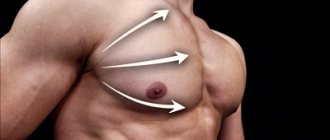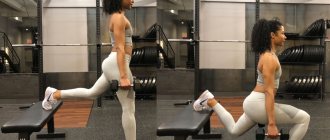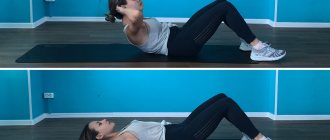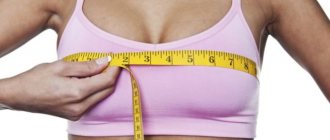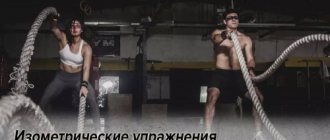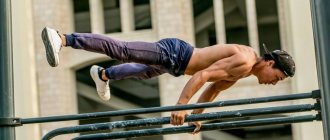When it comes to free weight exercises, we don't mean a bunch of spare barbells, but specific workouts using equipment that everyone is familiar with: dumbbells, kettlebells, medicine balls, barbells and sand bags.
And if you have the opportunity to take advantage of all this, perhaps it's time to learn how to do it right. Moreover, planning a workout can seem like a daunting task. How many reps or sets are best? How heavy should the weight be? What is triceps building and how to fit it into your training plan?
Don't worry future free weight exercise enthusiasts. We spoke to experts who created the exercises and answered the most important questions. Ready? Then let's continue.
What is the difference between weight training and free weight exercises?
Exercises on strength training equipment involve homogeneous movements in the same plane. Dumbbells, kettlebells and everything that relates to free weight can be used in different exercises, working a variety of muscles.
However, the choice most often comes down to what you have at home. And this is one of the advantages of free weight exercises: the equipment is compact and does not take up much space, be it dumbbells, kettlebells or barbells. All this can be stored at home without any problems.
Advantages and disadvantages of simulators
The undoubted advantage of simulators is safety – provided that they are used correctly. Exercise machines allow you to localize the load, provide better control of movement, and create load vectors that are not available when using free weights. Variable load machines allow muscles to contract closer to the length-force relationship. It would be useful to remember about simulators with direct feedback that effectively train balance, as well as other simulators using electronic load control systems.
Once again, the advantages of simulators are also their disadvantages. Restriction of freedom of movement and localization of the load lead to an unbalanced and somewhat one-sided effect, making it impossible to fully reproduce the movements that occur in real life. The design of the exercise machines is most suitable for the “average” person, which reduces the effectiveness of their use by people with high/short stature or “non-standard” length ratios of body parts. Even simulators with good parameter adjustments have some individual limitations of use. In block devices, the main disadvantage is the complication of the concentric phase of movement (the main load phase, the weight lifting phase) and the facilitation of the eccentric one.
How to warm up before training with free weights?
A proper warm-up is the key to a successful workout, as it avoids injury and prepares your muscles for the stress. Proper training, by the way, is not a case of spending 5 minutes in a kneeling lunge scrolling through missed social media posts on your smartphone.
Stretching is best done after exercise as it can potentially destabilize cold muscles before exercise.
A good warm-up is to do the same exercises you would do in a strength training session, but with little or no weight.
For example, let's say you're going to do some barbell squats during your workout. In this case, practice squats without weight during the warm-up.
Leg press
The 45 degree leg press is essential equipment for any gym. In most cases, the machine allows you to train the knee and hip extensor muscles, as well as the shin flexors. For beginners with a low level of readiness for loads, leg presses in the simulator are the main load for the leg muscles during the period of mastering the technique of squats and deadlifts. The leg press allows you to load the leg muscles without axial load on the spine, and this feature makes the machine useful for people of any fitness level.
How heavy should the free weight be?
How heavy the weight should be depends entirely on how strong you are, as well as your training history, the number of repetitions planned, and the purpose of the exercise.
However, to choose the right weight for your workout, ask yourself the following questions:
- Will I get enough exercise with this weight?
- Will I be able to complete the entire workout according to the planned list of exercises?
- Will I be able to perform all the reps correctly with this weight?
- Will I be able to complete all exercises with this weight?
- Do I feel that training is a challenge for me?
The ability to understand how and how much you can lift is another key to success.
"Once an exercise becomes easy, change it up," says renowned trainer PT Dalton Wong. – You can increase the weight, do more reps, increase the tempo, or perform the exercise differently. Your body likes to take the path of least resistance, so once it's used to the challenge, it's time to change your training conditions."
Calf flexion
Shin curls, which equipment manufacturers call leg curls, are also advisable to include in the training program. This is due to the structure of the biceps femoris muscle, one of the heads of which is not two-joint and may not be sufficiently loaded when performing squats and deadlifts. It is also important to remember that the human body combines open and closed kinematic chain movements, which means that both types of exercises must be used when training.
For example, calf curls and deadlifts for the hamstrings, squats and calf extensions for the quadriceps. The ratio of open and closed kinematic chain exercises in the program is selected individually, usually with a predominance of the latter.
Passages and emergency exits
The main passages in the hall. When planning a gym, you should leave sufficient aisles between machines. As a rule, most exercise equipment is placed in several rows with fairly narrow gaps between exercise equipment in the same row. Doors in the room should be located in front of the main passages of the gym; doors should not be cluttered, exits from them to the hall should be safe.
Emergency exits. When placing simulators, evacuation safety requirements must be observed. Passages to evacuation and emergency exits must be of the required width and free. The exits themselves must be unobstructed and accessible from the inside without a key. In some cases (children's gym, hall in a medical institution), regulatory authorities may require that the evacuation routes in the gym itself be fenced off with a low fence that channels the movement of people to emergency exits.
Bodyweight training area
A small specific group of exercise machines for working with your own weight includes: hyperextensions (back extension), press boards, crunch benches, pull-up and push-up machines (Hercules) and some others, including stretching benches (pre-workout stretching). This also includes adjustable and non-adjustable benches, but they can also be used for working with weights.
It is advisable to place the exercise machines for working with your own weight in a compact group, but since they can be placed anywhere, including in the center of the room, the place for them is determined after the placement of all other exercise equipment. If there is no space left in the hall to accommodate these exercise machines in one compact group, they are distributed throughout the hall.
Who is suitable for functional training?
This training method is suitable for you if:
- Due to age and/or a sedentary lifestyle, you begin to cope worse with everyday tasks, be it physical labor at work or active leisure, and you want to maintain and increase Systematic review of functional training on muscle strength, physical functioning, and activities of daily living in older adults their physical capabilities.
- You want to comprehensively develop your body, pumping up strength, flexibility, agility and endurance, but at the same time you don’t have enough time for exercise and are looking for a training system that would help improve different qualities at the same time.
- Are you going to work out at home or often go on business trips where you don’t have the opportunity to visit the gym.
When are simulators necessary for professionals?
Some exercises are quite problematic to perform without special equipment. A prime example is the lever and vertical pull. That is why professionals spend 30% of the time allotted for a lesson working on equipment.
In some cases, training with free weights is unacceptable even for athletes. We are talking about the recovery period after receiving various types of injuries. At this time, it is better to spend all the time allotted for the lesson on simulators. This will help reduce the degree of stress on the area weakened after treatment.
Discs for fingerboards
As we already understood, the neck is the basis for hanging discs. And discs are an additional adjustable weight for training. By the way, a barbell disc is also a free weight, and you can perform a large number of exercises with it even without the barbell itself. But that’s not about that now. The discs come in as wide a variety as the necks and locks for them. Disks are round and multi-faceted. Metal and aluminum. Chromed and rubberized. Colored and plain. Thin and thick. Large diameter and small. With or without carrying handles. In a word, there is complete diversity in taste and color here.
Whether this is good or bad, we will talk in conclusion, but for now you should know that no matter what the disk is - round, rubberized, green and thin. Or square, metal, red and thick, its main characteristics are weight and hole diameter. Both of these indicators are standardized. That is, no matter how manufacturers play with shape, material, color, thickness and diameter, the discs in any case must fit, firstly, either under the “amateur” bar of 25 or 28 mm (with a disc hole of 27 and 30 mm, respectively), or for an Olympic bar 50 mm (with a disc hole of 52 mm), as discussed above. Secondly, for both bar formats they are available in weights: 0.5/ 1.25/ 2.5/ 5/ 10/ 15/ 20 and 25 kg.
It is also worth paying attention to such an interesting point as color. To make it easier for judges and spectators to distinguish discs at weightlifting, powerlifting and other competitions, discs of a certain weight are painted in certain colors: 25 kg - red, 20 kg - blue, 15 kg - yellow, 10 kg - green. In competitive and Olympic sports, these colors are standardized, that is, mandatory. In fitness, they are purely symbolic, or even imitative, since fitness is a young industry that identifies itself more as a way of life than as a sport. Therefore, this correspondence between weight and color is not a mandatory requirement for the manufacturer.
Pneumatic simulators
A specific group of simulators consists of pneumatic simulators, in which the load is created by compressed air pressure. Pneumatic simulators SALTER (Spain) are presented on our website in more detail . We did not indicate the zone of pneumatic machines in the “Zoning” chapter, because pneumatic machines are extremely rare in gyms. But if they exist, they should naturally be separated into a separate zone.
When determining the location for the air training area, you should first determine where the compressor will be located (usually in a separate room). Then you need to make a plan for the placement of simulators, taking into account the optimal routing of pneumatic lines. Pneumatic ducts must be hidden on the floor, that is, installed in advance - before the pneumatic simulators are brought into the room.
Proper design of the free weights area is the key to the success of the fitness center
Much attention is also paid to appearance: after all, aesthetic equipment attracts the eye and improves mood, which has a beneficial effect on the effectiveness of training. Hampton produces a wide range of equipment to equip the dumbbell and barbell area, as well as proprietary storage systems. Their compact and convenient placement will add attractiveness to the gym. In addition, the manufacturer offers halls and clubs the opportunity to place their logo on the products. Such personification significantly increases the status of the fitness club in the eyes of visitors. Hampton dumbbell, bar and barbell sets come in a variety of designs and styles. For example, a set of dumbbells from the Jelly Bells series, barbells with discs of the original Gel Pump configuration, and a set of Gel-Bars body bars for aerobic exercises will delight you with bright, attractive colors. Dura-Bell urethane barbells and dumbbells with hex heads look original, and the Beauty-Grip series attracts with sparkling chrome on almost the entire surface, excluding the middle part of the handle. Chrome plating is also used in the Eclipse dumbbell models, as well as in the Gel Grip and Ultra-Bell series, where the shine of the metal is stylishly combined with the black color of the coating. Racks with sets of dumbbells and barbells look very solid and stylish. Hampton pays close attention to the original design of racks specifically designed for use in fitness clubs.
Who is better to exercise on simulators?
Almost all beginners who visit the gym for the first time intuitively head towards the treadmill. And they do it right, since getting to know the fitness industry should begin with exercise equipment.
In addition, such classes are suitable for middle-aged people and people with certain health problems. The instructor will draw up a training plan in such a way that during it problem areas are worked out and areas that are contraindicated are unloaded.
How to instill culinary skills from the age of 3: step-by-step instructions for parents
Russians may be banned from going to the cinema with brought food
21-year-old Semyon Treskunov spoke openly about his mother for the first time
Cardiozone
1) Sockets for connecting exercise equipment to AC power must be located close to the exercise equipment. Wires lying across the aisles between machines should be avoided.
2) A safety zone must be provided behind each treadmill - a free space of at least 150 cm, which will allow the exerciser to avoid injury if he falls from the machine.
3) When using chest heart rate sensors (type Polar T31), cardio equipment should be installed at a distance of at least 130 cm between their longitudinal axes to avoid conflicting sensor signals.
4) Cardio training is effective only when it is long – up to an hour or more. At the same time, training on simulators is monotonous. Typically, students are offered to watch television programs or videos. Many modern cardio machines allow you to view programs and films on a monitor located on the control console in front of the exerciser. However, large video monitors for general viewing are often installed in the room. These monitors should be placed so that from any cardio equipment at least one monitor is visible directly in front of the exerciser or at a slight angle.
5) In the absence of video monitors, you should think about what those exercising will see in front of them during long-term work on cardio equipment. It is recommended to orient cardio equipment “facing” the windows or, if there are no windows, towards the gym (but not at the expense of the safety zone behind the treadmills).
Attention! A safety area must be provided behind the treadmills. Domestic gyms, as a rule, do not have an excess of free space, so a close wall behind the track is a common occurrence. But if a flat wall is not so bad, then it is absolutely forbidden to place the path so that there are protruding elements of any purpose behind it! Otherwise, if a person falls from the exercise machine, serious injuries may occur. The easiest way to ensure a safety zone is to orient the back side of the treadmills towards the passage between the exercise machines - then the safety zone and the passage will be combined, that is, space will be saved. However, the width of the passages must be at least 150 cm.
